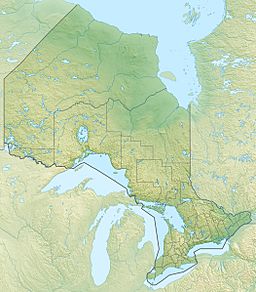Moira Lake facts for kids
Quick facts for kids Moira Lake |
|
|---|---|

Postcard of Moira Lake
|
|
| Coordinates | 44°29′00″N 77°27′25″W / 44.48337°N 77.45706°W |
| Type | Lake |
Moira Lake is a beautiful lake located in Hastings County, Ontario, Canada. You can find it near Madoc, right by Highway 62 and Highway 7. Many people enjoy visiting the lake, and there are lots of cottages along its shores. The Moira River flows into and out of Moira Lake. There's even a place to launch boats and a trail that follows an old railway line!
Contents
What's in a Name?
The name "Moira Lake" comes from a Greek word meaning "share" or "destiny." The lake has three islands, each with its own name:
- Papoose Island (Papoose is a Native American word for a baby or small child)
- Green Island
- Stony Island
How Big is Moira Lake?
Moira Lake covers an area of over 2000 acres. It's not super deep, with a maximum depth of 36 feet and an average depth of 14 feet. The lake is actually made up of two parts:
- The Lower Lake, which is the bigger section.
- The Upper Lake.
The Moira River flows into the Upper Lake and then drains out from the eastern end of the Lower Lake. Moira Lake is not part of the larger Trent Waterway system; it's a "closed lake," meaning it doesn't connect to other major waterways. You can travel about 1 kilometer by boat on the river at both ends of the lake before rocks or dams stop you.
Lake Health: Water Quality
Moira Lake is considered "borderline eutrophic." This means it has a lot of nutrients, which can cause a lot of algae and weeds to grow, especially in late summer. Sometimes, people who own cottages hire special machines to clear the heavy weeds so their boats can get through.
The lake has a limestone bottom. This is good because it helps protect the lake from becoming too acidic due to acid rain.
During very dry summers, the Moira River might stop flowing into or out of the lake. This helps keep the lake's water level more consistent.
The town of Madoc's wastewater treatment center releases treated water into the lake twice a year. This usually happens for two periods, each lasting about 28 to 45 days. This treated water contains some natural substances, but it stays within the safe limits set by the government. For example, in 2018, about 347,103 cubic meters of treated water were released.
The History of Madoc
Moira Lake is close to the town of Madoc. The town was founded by Donald MacKenzie in the early 1830s. He built a saw mill and a grist mill there. For about 20 years, the community was known as Mackenzies Mills. Later, it was called Hastings, and finally, Madoc.
Madoc once had a very exciting time when gold was discovered nearby!
- In 1866, two men, Marcus Powell and an old miner named Snider, found a vein of pure gold on John Richardson's farm.
- The gold was very high quality, so the news quickly spread.
- This discovery started a "gold rush" that was almost as big as the one in California!
- Madoc became famous, appearing in newspapers and magazines across Europe.
- The town's population grew very fast, from 900 people to 5000!
- Many of the gold mines didn't last because it was too hard and expensive to get the gold out.
- However, other valuable minerals like copper, lead, marble, and talc were found instead.
Wildlife in Moira Lake
Moira Lake is surrounded by the typical plants and marshy areas you'd find in eastern Ontario. A lot of the shoreline has cottages, so much of the lake's edge has been changed by people. This has led to more fishing, which can put pressure on fish populations. For example, too much ice fishing in winter has affected the number of perch and walleye in many Ontario lakes, including Moira Lake.
Even so, Moira Lake is home to many different types of fish, such as:
- Largemouth bass
- Walleye
- Northern pike
- Musky
- Perch
- Catfish
- Rock bass
- Longnose gar
- Bluegill
- Smallmouth bass
While there's a great variety of fish, some studies suggest that "overfishing of various species" and other issues, like changes in the tiny plants in the water due to mining and farming, have caused the overall fish populations to drop.
Protecting Moira Lake
In the past, during the 1900s, Moira Lake faced problems from pollution. Arsenic and other metals were released from the nearby Deloro Mine and Deloro River. For example, a report from 1993 showed that a lot of arsenic and toxic metals had built up in the lake's sediments since the 1830s when mining began. Even though the mine closed in 1961, polluted water from the abandoned mine wastes was still flowing into the lake.
However, the government of Ontario started a huge project called "The Deloro site cleanup project." This multi-million dollar effort has been very successful! It has reduced the amount of arsenic flowing into the Moira River from the Deloro site by over 90 percent. This is great news for the lake's health!
Another challenge for the lake is the invasion of zebra mussels. These tiny mussels likely arrived in the lake on boats from other places where they live, or they might have traveled through the Moira River from Lake Ontario. Efforts to control the zebra mussel population have had some positive effects.
Studies have also shown that Moira Lake has high levels of phosphorus. Phosphorus can cause a lot of algae to grow. This is due to several things, including the lake's shallow average depth, farming practices nearby, and past industrial activities.


